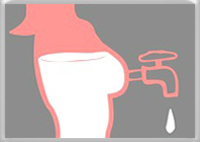Oversupply - Eight Ways to Diagnose
Oversupply... It seems a little odd to be placing this article under “Breastfeeding Problems”. My milk supply has always been low, and having too much milk sounded more like a blessing to me, rather than a concern.

However, oversupply (also known as overactive let-down) is a real problem and can cause immense discomfort and inconvenience for both mom and baby.
You may suffer from an overabundant milk supply if:
- Your breasts leak consistently and milk sprays vigorously at let-down. Leaking is normal during the first weeks after delivery. Milk supply is only getting established. But your breasts shouldn't leak consistently for a long time.
- Your breasts feel full and engorged all the time. It is normal during the first weeks after delivery. Soon supply should adjust to meet the demand and engorgement should go away.
- Your baby gulps and chokes on your milk, because the flow is so fast. The baby may even spit up excessively and be gassy after most of the feedings.
- Your baby gains weight very well. Although a good thing on its own, when combined with some other symptoms, it may mean oversupply.
- Your baby has mucousy, greenish or explosive stool. A baby may have more than 3 bowel movements a day during the first month. After release of black meconium (baby’s first stool), baby's stool changes to brown, and then finally to the color and consistency of mustard. It means your baby starts getting high-calorie hindmilk. Watch for mucousy, greenish, and explosive stools. This is a sign of foremilk/hindmilk imbalance.
- You see blood in your baby’s stool.
- Your baby never looks relaxed and isn't able to fall asleep at the breast. Most breastfed infants find it so soothing and relaxing to be at the breast, that they easily fall asleep after eating. Vigorous milk flow prevents babies from having some comfort-sucking time at the end of the feeding.
- You suffer from prolonged cracked or sore nipples, engorgement, clogged milk duct, or mastitis. Your breasts don’t get fully emptied and fast flow doesn’t let the baby to latch on correctly.
Are All Oversupplies the Same?

There are two aspects of oversupply:
- If you have any symptoms except bloody, mucousy or greenish baby stool, you are most likely dealing with pure oversupply.
- If your baby’s stool quality and quantity are out of balance, it may mean that milk overabundance causes lactose “overdose”.
What is Lactose Overdose?
When the baby starts sucking, low-fat foremilk is the first to come out, followed by heavier calorie-rich hindmilk.
In women with overabundant milk supply, babies have to suck for a long time to reach hindmilk.
When hindmilk is not reached during one feeding, newly produced milk moves it even further to the back. During the next feeding the baby is again unable to reach the hindmilk.
The amount of lactose in fore- and hindmilk is the same, but there is more fat in the hindmilk. This fat slows down digestion and allows enough time for enzyme lactase to digest the lactose.
If foremilk/hindmilk balance is off and the baby is getting a lot of foremilk and only some hindmilk, his body is getting lots of lactose and no fat. Lactose then rushes through the intestines without proper digestion.
Undigested lactose that reaches large intestine, ferments there and irritates the intestine. This causes gassiness, and greenish, mucousy or bloody stool.
Babies suffering from lactose overdose may still be gaining weight well due to sufficient volume of milk intake. But they get hungry faster.
Important: Bloody stool may also be a sign of food allergies or lactose intolerance. However, if
there are other symptoms of milk oversupply, then oversupply is most likely the
reason for blood in your baby’s stool.
My son had blood in his stool, but my milk supply was low. So I knew it was food allergies, not oversupply. Make sure you talk to your doctor before making any conclusions and taking measures.
If blood persists after you get your milk supply under control, give it some more time. It may take up to a month for your baby’s intestine to heal completely.
What To Do About Milk Oversupply
Whether you have pure overactive let-down or lactose overdose, your goal is to decrease the amount of milk your body produces. Take caution: it is easy to go from too much milk to a low milk supply.
♦ If you and your baby are not bothered by your milk flow, I'd leave it as is.
♦ If there is a lot of milk left in your breasts after the feeding, pump it to prevent engorgement and donate to a local milk bank.
♦ If there is only little milk left, don't pump. The more milk leaves your breasts, the more new milk comes in.
♦ If your milk abundance makes you and the baby uncomfortable, here is how to manage it.
Home › Breastfeeding Problems › Oversupply
















